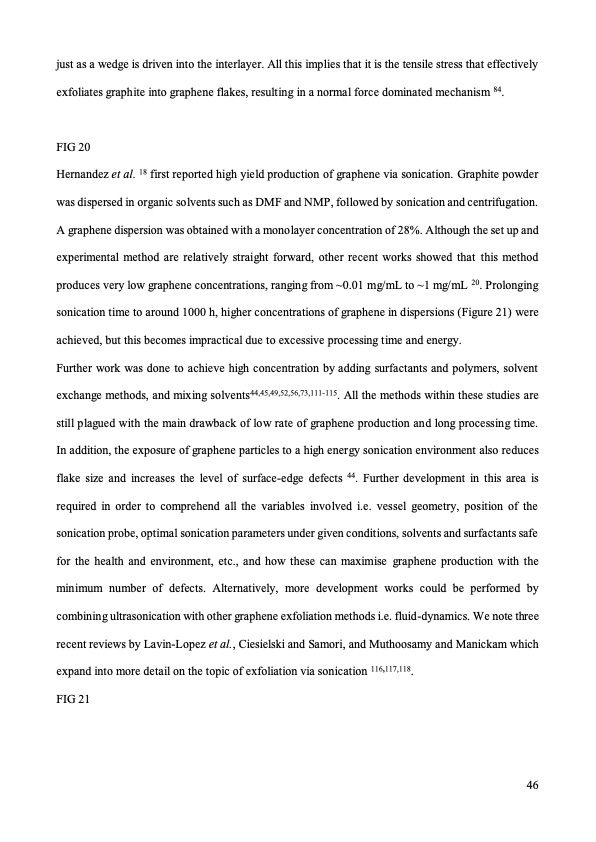
PDF Publication Title:
Text from PDF Page: 046
just as a wedge is driven into the interlayer. All this implies that it is the tensile stress that effectively exfoliates graphite into graphene flakes, resulting in a normal force dominated mechanism 84. FIG 20 Hernandez et al. 18 first reported high yield production of graphene via sonication. Graphite powder was dispersed in organic solvents such as DMF and NMP, followed by sonication and centrifugation. A graphene dispersion was obtained with a monolayer concentration of 28%. Although the set up and experimental method are relatively straight forward, other recent works showed that this method produces very low graphene concentrations, ranging from ~0.01 mg/mL to ~1 mg/mL 20. Prolonging sonication time to around 1000 h, higher concentrations of graphene in dispersions (Figure 21) were achieved, but this becomes impractical due to excessive processing time and energy. Further work was done to achieve high concentration by adding surfactants and polymers, solvent exchange methods, and mixing solvents44,45,49,52,56,73,111-115. All the methods within these studies are still plagued with the main drawback of low rate of graphene production and long processing time. In addition, the exposure of graphene particles to a high energy sonication environment also reduces flake size and increases the level of surface-edge defects 44. Further development in this area is required in order to comprehend all the variables involved i.e. vessel geometry, position of the sonication probe, optimal sonication parameters under given conditions, solvents and surfactants safe for the health and environment, etc., and how these can maximise graphene production with the minimum number of defects. Alternatively, more development works could be performed by combining ultrasonication with other graphene exfoliation methods i.e. fluid-dynamics. We note three recent reviews by Lavin-Lopez et al., Ciesielski and Samori, and Muthoosamy and Manickam which expand into more detail on the topic of exfoliation via sonication 116,117,118. FIG 21 46PDF Image | graphene production via nonoxidizing liquid exfoliation

PDF Search Title:
graphene production via nonoxidizing liquid exfoliationOriginal File Name Searched:
Graphene-R2-review.pdfDIY PDF Search: Google It | Yahoo | Bing
Salgenx Redox Flow Battery Technology: Power up your energy storage game with Salgenx Salt Water Battery. With its advanced technology, the flow battery provides reliable, scalable, and sustainable energy storage for utility-scale projects. Upgrade to a Salgenx flow battery today and take control of your energy future.
| CONTACT TEL: 608-238-6001 Email: greg@infinityturbine.com | RSS | AMP |